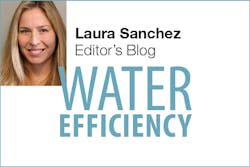For weeks I thought I had a skunk problem. Every evening, the scent returned. But as it turns out, odiferous varmints were not to blame. My home, nestled in an agricultural region of California, has recently found itself at the epicenter of the cannabis industry. And it seems that this burgeoning agricultural business may affect more than one’s olfactory receptors.
Six western states have legalized cannabis—Washington, Oregon, Nevada, Colorado, Alaska, and California. But a number of water professionals are asking how the growth of this industry might impact water resources.
Cannabis cultivation has the potential to affect water resources in a variety of ways according to experts, but primary concerns are that irrigation withdrawals could reduce the flow of streams or that wastewater could pollute waterways with agricultural chemicals. To date, however, no one—neither regulatory officials, policymakers, nor growers—can offer a definitive answer regarding how this nascent industry might impact water in the West.
Growing cannabis requires a significant amount of water; that much is clear. But because of the former illegality of its cultivation, there is little data tracking the industry’s water consumption. The California Department of Fish and Wildlife asserts that a cannabis plant grown outdoors in Northern California can consume as much as 6 gallons of water per day, but the industry’s growers contend that 2.3 gallons per day is a far more realistic estimate. Furthermore, they explain that many cannabis operations are taking over acreage once dedicated to more water-intensive crops such as alfalfa, and therefore may conserve water in comparison.
Growers also explain that cannabis offers more economic value per gallon of water or acre of land than many other crops. States keen to benefit from taxes on this high-value crop have worked to develop new regulatory frameworks focused on water consumption. And each state seems to be handling these legislative structures differently.
The state of Washington has attempted to regulate water usage by limiting the number of grower licenses it offers as well as the number of retailer licenses. Colorado’s rules prohibit the application of certain chemicals during cultivation and limit commercial marijuana cultivation to indoor grow operations which can be more easily monitored. While some states require minimal oversight, others have rigorous regulatory processes.
California’s rules for irrigation water allocations, runoff, and wastewater produced are far more detailed, as outlined by Water Deeply. While many states grant first-come, first-served “appropriative” rights for available water, in California, “riparian” rights mean that growers near a stream have access to a water supply. Therefore the strategy lawmakers are pursuing is to limit the amount of water that must be flowing through a channel before water can be diverted for marijuana growth to ensure that resources aren’t overly taxed. They will also limit the acres of land a grow operation can disturb and will regulate wastewater disposal and permitting through cooperation with local, state, and federal law enforcement.
What predictions do you have for the cannabis industry’s effect on water in the West? What suggestions do you have for the regulatory frameworks?
